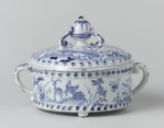Filled with Scent of the Orient
The spherical part of this functional jewel is made out of 6 sections, each of which is actually a little box with a lid. (Fig. 11) These small carriers were meant for balms made with cinnamon, clove mace, angelica, rose and coal tar, which could serve as perfume as well as medicine. In early modern thinking, sickness was believed to be caused by inhaling bad air and the scent of sweet aromas and spices could prevent illness. Sniffing the scents from a pomander was also a great way to prevent smelling the stench of the city.
Discovering routes that led directly to exotic spices in the, soon to be colonial, regions in the East, was an important incentive for the voyages undertaken by the seafaring nations of Europe at the end of the 15th and the beginning of the 16th century. Spices played an important role in Europe, especially for the elite, considering they were the ones who could afford this luxury product.
Spices were believed to be a cure and prevention for diseases, but were more than just a luxury product with attributed medical powers. Their appeal grew from their rarity, and the mysterious exotic source from which they came was equally important.
Diamonds weren’t the only valuables believed to be guarded by dangerous serpents. Pepper was believed to come from trees in India, and acquiring this spice involved burning trees to get rid of the venomous and dangerous snakes living in these “pepper forests”. The fabricated ‘truth’ about how difficult it was to gather spices led to an increased attractiveness. Even when the East was further explored and documented, this impression remained, until the attributed medicinal value ultimately declined in the 18th century.
The gems are beautiful, but also provide protection. The spices create a nice fragrance, but also have the power to repel bad air. Even the shape contributes to its wearer’s health. But who was the audience for this medicinal jewel? Read more about this in the last step!
